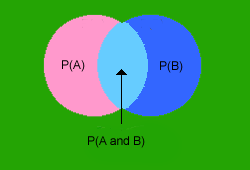Useful Web Resources
Conditional Probability and Independence
Conditional Probability- Wikipedia, the free encyclopedia
Stats: Conditional Probability

Solutions
Let A be the event that the class passed the first test. The B be the event that the class passed the second test.
P(B|A)=0.29/0.37=0.78

Let A be the event of drawing a Heart on the first draw. Let B be the event of drawing a Heart on the second draw. Let C be the event of drawing a Heart on the third draw.We know that P(A ∩ B ∩ C) = P(A)P(B|A)P(C|A and B). So P(A)=13/52, because there are 13 Hearts in a deck of cards. Given that the first card was a Heart, there would be 12 Hearts left in the 51 cards. So the probability of drawing a Hearts on the second draw is P(B|A) =12/51. Given that the first two cards were Hearts, there would be 11 Hearts in the remaining 50 cards. So P(C| A and B)=(13/52) x (12/51) x (11/50).

A:The daily production of candy canes from M1 is 11%. So P(M1)=0.11
B: The percentage of broken candy canes from M2 is P(B|M3)=0.03
C: P(M2)P(B|M2)=(0.56)(0.01)= 0.0056
D: P(M3)P(B|M3)=(0.33)(0.03)= 0.0099
E: The probability that a selected broken candy cane came from M2 is P(M2|B)= P( M2 and B) / P(B) =(0.56)(0.01)/(0.0177)=0.32
F: The probability that a selected broken candy cane came from M3 is P(M3|B)= P( M3 and B) / P(B) =(0.33)(0.03)/(0.0177)=0.56

.
